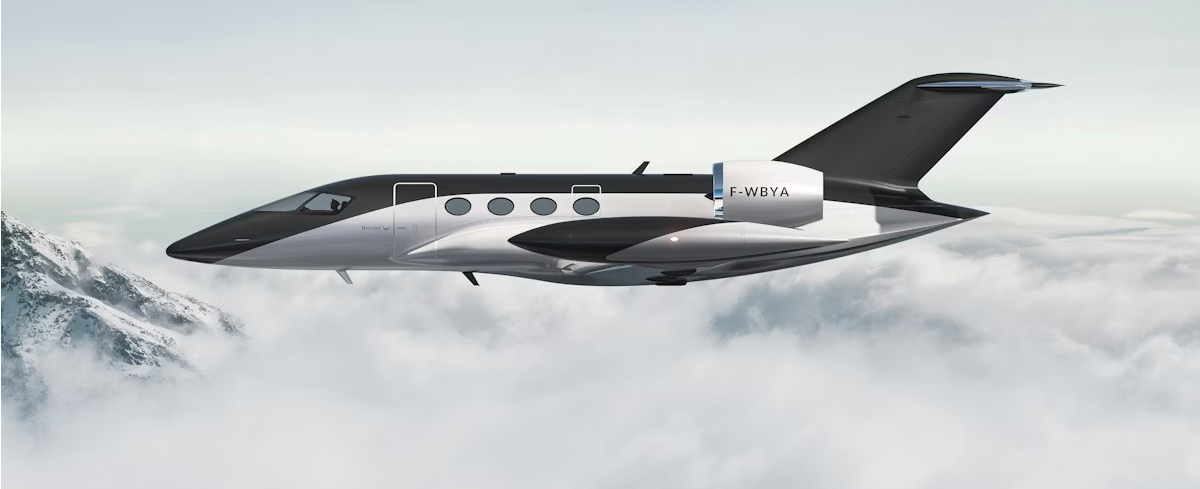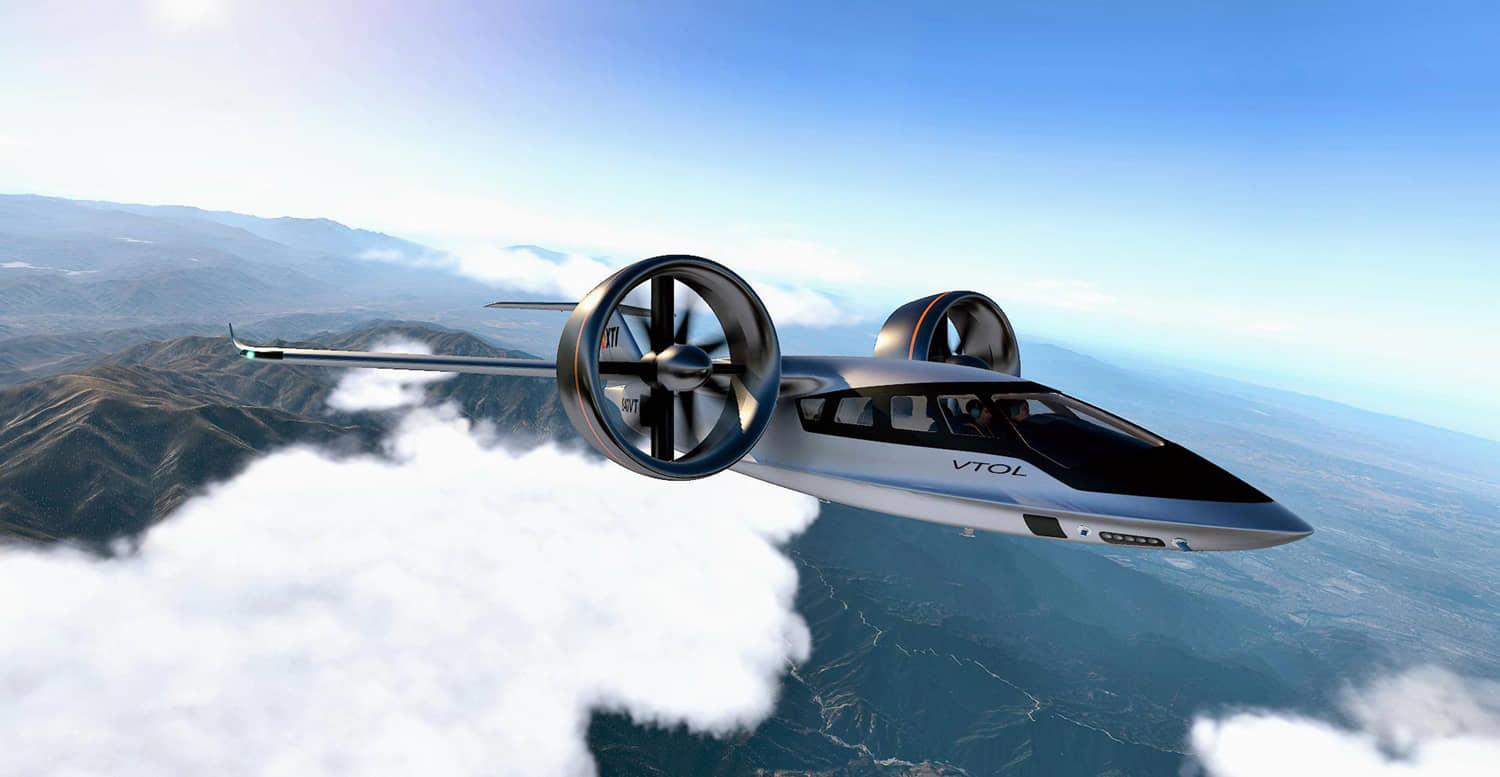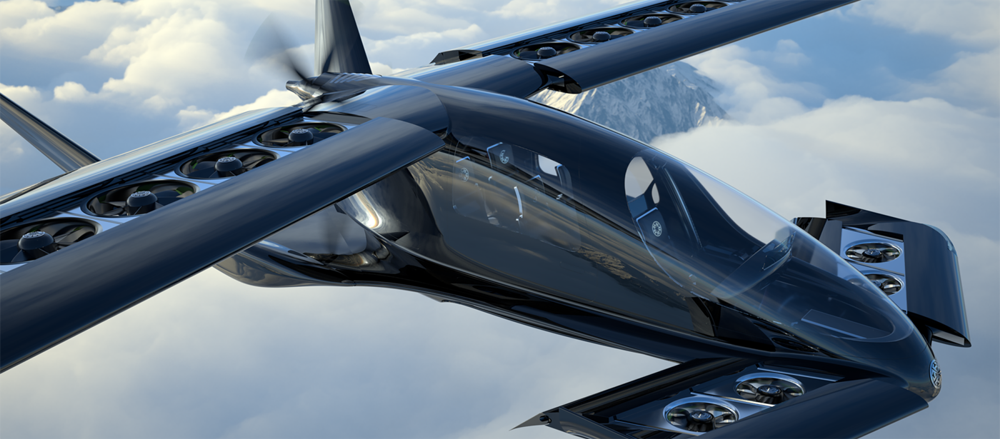The Pilatus PC-24 combines a turboprop’s versatility with a light jet’s performance. Dubbed the “Swiss Army Knife” of private jets, this remarkable aircraft has carved out a unique niche in the aviation market since its introduction.
Following the success of the PC-12 single-engine turboprop, Pilatus Aircraft embarked on an ambitious journey in 2007 to develop a jet that would offer significantly greater range and speed while preserving the PC-12’s rugged versatility and short-field performance capability. The Swiss manufacturer assembled a team of over 300 engineers dedicated to creating an aircraft that would redefine what a business jet could do.
The PC-24 was officially unveiled on May 21, 2013, at the European Business Aviation Convention & Exhibition (EBACE) in Geneva. During this introduction, Pilatus chairman Oscar Schwenk described it as “an exceedingly unique aircraft that did not fit into any of the existing categories of business jets.” The prototype made its maiden flight on May 11, 2015, leading to EASA and FAA certification on December 7, 2017. The first customer delivery occurred on February 7, 2018, to PlaneSense, a fractional ownership company based in Portsmouth, New Hampshire.
Since then, Pilatus has delivered more than 212 PC-24 aircraft worldwide as of Q1 2024. The global fleet had logged 33,500 flight hours by January 2021, demonstrating the rapid market adoption of this innovative aircraft. As of 2023, the PC-24 fleet includes 186 wholly-owned aircraft, 24 fractional ownership, and six shared ownerships, with North America accounting for 56% of the fleet and Europe representing 29%.
Design Philosophy and Unique Features
The PC-24 embodies Pilatus’s commitment to versatility and practicality. Positioned as a light jet with a midsize cabin (Super Light Jet), it offers an unmatched combination of capabilities that operators say has no direct competitors in the market.
Revolutionary Airframe Design
The PC-24 features a low-wing cantilever cabin monoplane powered by two Williams FJ44-4A turbofans mounted in nacelles on the sides of the rear fuselage. Its T-tail design and retractable tricycle landing gear support its exceptional versatility. The aircraft’s advanced wing design incorporates a large double-slotted flap system that achieves remarkable short-field performance with a stall speed of only 81 knots at maximum landing weight.
One of the PC-24’s most distinctive features is its long-stroke trailing link landing gear, which smooths out uneven surfaces and allows the aircraft to operate from unpaved runways. Its dual-wheel main wheels have 70 psi (4.8 bar) of pressure to prevent sinking in soft surfaces, while the wing flaps have a replaceable, abradable surface and shields that protect the high-mounted engines from loose debris.
Spacious and Versatile Cabin
The PC-24’s cabin represents a significant advancement over typical light jets. With dimensions of 23 feet in length, 5.7 feet in width, and 5.1 feet in height, the cabin offers 501-503 cubic feet of volume with a flat floor. This generous space can accommodate 8-10 passengers in various configurations.
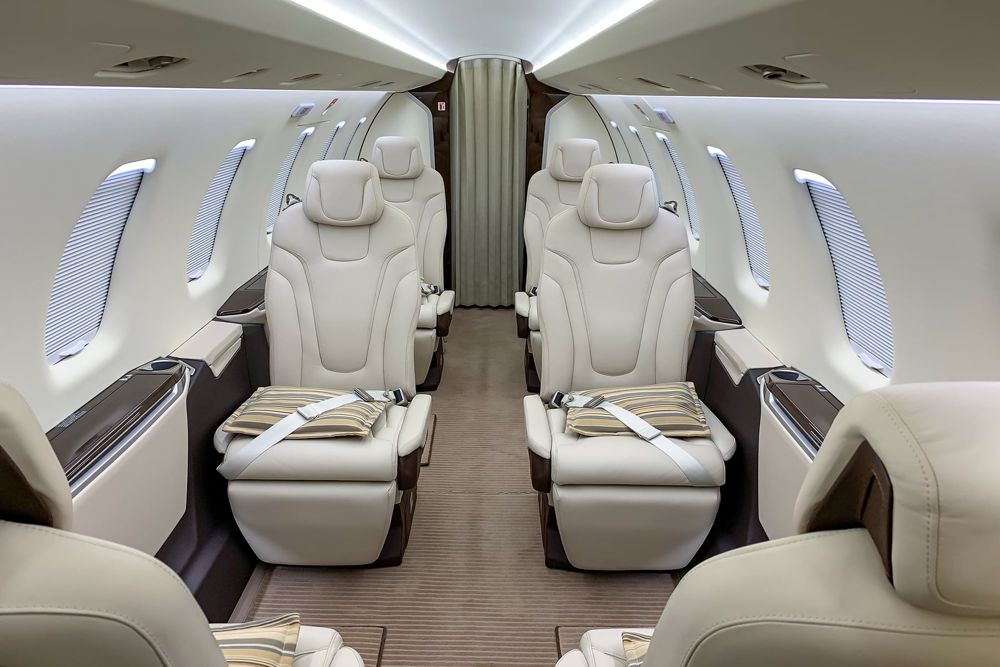
The aircraft’s 17-square-foot cargo door is its most extraordinary feature, making the PC-24 the first production business jet purpose-built for combination passenger and freight missions. This feature enables the quick-change interior to be configured for four, six, or eight passengers as needed, accommodating 90-200 cubic feet of cargo.
The cabin offers three exits: a passenger door on the left side near the front, overwing emergency exits on each side, and the cargo door on the left side at the rear. BMW Designworks designed the interior color schemes, which provide a luxurious passenger experience with exceptional comfort.
Advanced Cockpit Technology
Pilatus collaborated with Honeywell to develop the PC-24’s Advanced Cockpit Environment (ACE) based on the Honeywell Primus Epic 2.0 avionics system. The flight deck features four 12-inch displays that provide pilots with comprehensive information and control.
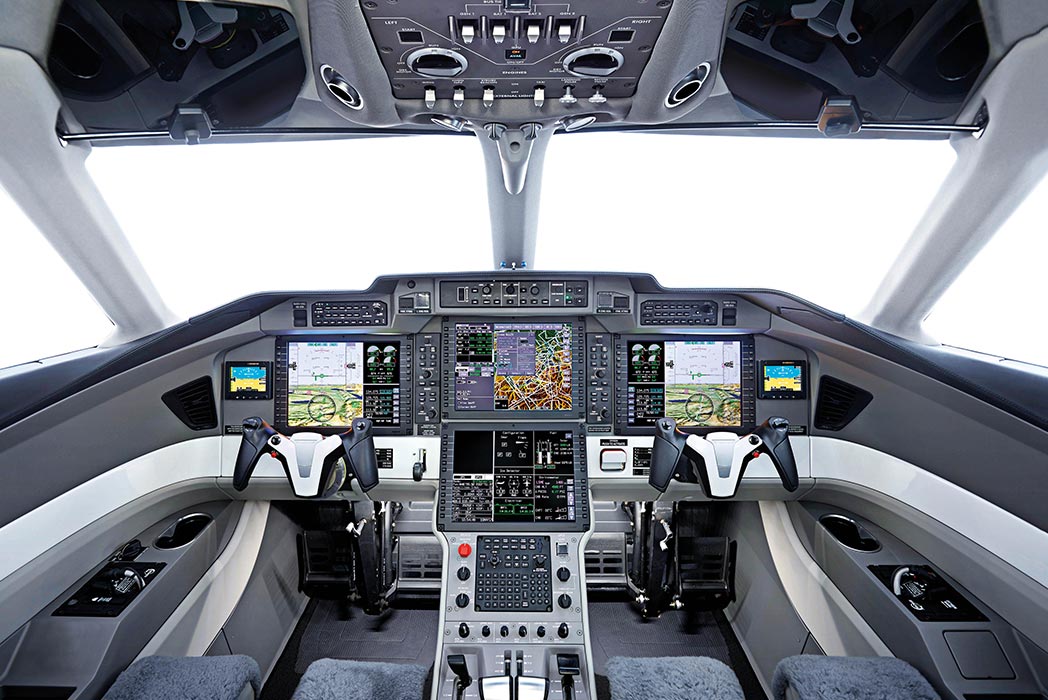
The system was designed to reduce pilot workload, allowing the PC-24 to be single-pilot certified. However, many operators, including charter companies like Stratos Jet Charters, require two pilots for enhanced safety.
In July 2021, Pilatus updated the aircraft with several refinements, including touchscreen-controlled avionics, tactile feedback in pitch and roll, limit protection, pilot-defined visual approaches, and automated audible callouts. These updates can be retrofitted to earlier production aircraft.
Performance Capabilities
The PC-24 delivers impressive performance metrics that combine the best attributes of multiple aircraft categories, making it versatile across various operational scenarios.
Range and Speed
The PC-24 offers a maximum range of 2,000 nautical miles with six passengers (approximately 1,200 lbs payload) and 2,123 nautical miles in ferry configuration with no payload. This range enables non-stop flights between major city pairs such as New York to Dallas or London to Istanbul.
While its maximum speed of 425-440 knots (787-506 mph) is slightly lower than some competitors, the difference is minimal in practical terms. For example, on a 1,250 km flight, the PC-24 would take just six minutes longer than faster competitors but would still be more than one hour and 15 minutes faster than the PC-12 turboprop.
At 45,000 feet and 7,260 kg (16,010 lb), the PC-24 achieves a long-range cruise speed of Mach 0.65 (372 knots/689 km/h) with a total fuel flow of 850 lb (390 kg) per hour. At its high-speed cruise of Mach 0.74, fuel flow increases to 970 lb (440 kg) per hour.
Exceptional Short-Field Performance
One of the PC-24’s most remarkable capabilities is its short takeoff and landing (STOL) performance. The aircraft requires just 2,690-2,930 feet of runway for takeoff, significantly less than its competitors. This capability allows the PC-24 to access approximately 11,700 airports with paved runways worldwide, and when unpaved surfaces are included, this number increases to more than 20,000 potential destinations.
The PC-24’s ability to operate from unpaved runways is unique in the business jet market. One pilot reported comfortably operating the aircraft from 3,000-foot or shorter runways with full fuel on hot days, noting that its low-pressure tires and aggressive lift dump system make stopping quick and easy.

Payload and Fuel Efficiency
The PC-24 has a useful load of 6,679 lbs, consisting of 5,964 lbs of maximum usable fuel plus 715 lbs of payload with full fuel. This configuration gives the aircraft a range of approximately 2,000 nm at long-range speed with reserves.
The aircraft offers flexibility in the payload-range equation. If operators need to carry the maximum payload of 2,500 lbs, they must reduce fuel to 4,179 lbs., which cuts the range to about 1,500 nm. This versatility allows operators to optimize the aircraft for specific mission requirements.
Despite having a larger cabin and better short-field performance than competitors like the Learjet 75, the PC-24 maintains excellent fuel efficiency. At cruise altitude, its Williams FJ44-4A engines provide an optimal balance of performance and economy.
Market Position and Applications
The PC-24 occupies a unique position in the business aviation market due to its combination of jet performance with turboprop versatility. This distinctive blend of capabilities has led to its adoption across various sectors.
The PC-24 has proven popular with the two biggest PC-12 fleet operators in the private and business aviation segment: PlaneSense in the United States and JetFly Aviation SA in Europe. George Antoniadis, CEO and president of PlaneSense describes the PC-24 as “a special value proposition” because “it’s a light jet, but the cabin is a lot more than that [size].”
The aircraft’s versatility makes it ideal for owner-operators and charter companies seeking to access remote or challenging destinations while maintaining a business jet’s speed and comfort advantages. The PC-24’s ability to configure the cabin for various missions provides operational flexibility not typically found in other light jets.
Special Missions and Medical Transport
The PC-24’s unique capabilities have made it particularly valuable for special missions and medical transport operations. Australia’s Royal Flying Doctor Service (RFDS) configures its PC-24s as “emergency wards in the skies,” equipped with three litters and seats for four doctors and nurses. The RFDS reports that its three PC-24s can reduce aeromedical transport times by nearly half compared to its single- and twin-engine turboprops.
The aircraft’s speed, range, short-field performance, and large cargo door make it exceptionally well-suited for medical evacuation missions. These same attributes have attracted government organizations and other special mission operators.
Diverse Operator Base
The PC-24’s global operator base includes private companies, charter operators, fractional ownership programs, government agencies, and specialized service providers. Notable operators include:
- PlaneSense: Operates six PC-24 aircraft in its fractional fleet
- JetFly Aviation SA: European charter operator and management company
- Royal Flying Doctor Service of Australia: Operates four PC-24 aircraft for aeromedical missions
- FlyingGroup: Operates nine PC-24 aircraft
- Qatar Emiri Air Force: Operates two PC-24 aircraft
- Svenskt Ambulansflyg (Sweden): Operates six aircraft with four options
This diverse operator base demonstrates the PC-24’s adaptability to various operational requirements and environments.
Competitive Analysis
The PC-24 competes primarily with other light jets, though its unique capabilities and midsize cabin place it in a category of its own. The main competitors include the Embraer Phenom 300E, Cessna Citation CJ4, Cessna Citation CJ3+, and Bombardier Learjet 75 Liberty.
Comparative Specifications and Performance
| Specification | Pilatus PC-24 | Embraer Phenom 300E | Cessna Citation CJ4 | Cessna Citation CJ3+ |
|---|---|---|---|---|
| Price (New) | $11.9-12 million | $10.995 million | $9.61 million | $8.56 million |
| Cabin Volume | 501-503 cubic ft | 425 cubic ft | 311 cubic ft | 286 cubic ft |
| Length | 55 ft 2 in | 51 ft 4 in | 53 ft 4 in | 51 ft 2 in |
| Wingspan | 55 ft 9 in | 52 ft 2 in | 50 ft 10 in | 53 ft 4 in |
| Height | 17 ft 4 in | 16 ft 9 in | 15 ft 5 in | 15 ft 2 in |
| Range | 2,000-2,035 nm | 2,010 nm | 2,165 nm | 2,040 nm |
| Max Speed | 425-440 knots | 453 knots | 451 knots | 415 knots |
| Takeoff Distance | 2,690-2,930 ft | 3,209 ft | 3,410 ft | 3,180 ft |
| Landing Distance | 2,525 ft | 2,218 ft | 2,940 ft | 2,770 ft |
| Special Capabilities | Unpaved runway operations, large cargo door | Standard runway operations | Standard runway operations | Standard runway operations |
| Engines | Two Williams FJ44-4A | Two Pratt & Whitney PW535E1 (3,478 lbf each) | Two Williams International FJ44-4A (3,621 lbf each) | Two Williams FJ44-3A (2,820 lbf each) |
| Max Operating Altitude | 45,000 ft | 45,000 ft | 45,000 ft | 45,000 ft |
The PC-24 distinguishes itself with its superior short-field performance, larger cabin volume compared to the Citation CJ4, and unique ability to operate from unpaved runways. While competitors like the Phenom 300E and Citation CJ4 offer slightly higher cruise speeds, the PC-24’s versatility and cabin space provide significant advantages for operators requiring access to challenging destinations or multiple mission capabilities.
Strengths and Limitations
The PC-24’s primary strengths include its short-field performance, unpaved runway capability, large cargo door, spacious cabin, and operational versatility. These features enable it to serve markets and destinations typically inaccessible to other business jets.
However, the aircraft does have some limitations. Its maximum takeoff weight of 18,300 lbs. is lighter than similar-sized jets, and its high-speed cruise of Mach 0.74 is slightly lower than some competitors. One pilot noted that when operating at heavy weights and high altitudes, the aircraft might start at Mach 0.69 and gradually increase to its maximum operating Mach number as fuel is consumed.
Despite these minor limitations, the PC-24’s unique combination of capabilities attracts operators seeking a versatile business jet that can operate in challenging environments while providing the comfort and performance expected from a modern business aircraft.
Operational Experience and Pilot Feedback
Pilots with experience flying the PC-24 have provided valuable insights into its operational characteristics and real-world performance. One pilot with significant time in the aircraft noted that the PC-24’s short-field performance is “astounding,” allowing comfortable operations from 3,000-foot or shorter runways with full fuel on hot days.
The same pilot reported strong climb performance, reaching cruise altitude in approximately 20 minutes, even at maximum takeoff weight on hot days. They described the interior as “incredible,” stating that it “blows the Citation XL away in most categories.”
While the PC-24 has received overwhelmingly positive feedback, pilots have noted that it can be challenging to land initially, requiring some adaptation period. One pilot with about 20 hours of experience in the aircraft commented, “It’s a really crappy plane to land! I have about 20 hours in the plane now, and I’m finally getting used to it”. However, this same pilot also noted that they could perform touch-and-go landings on a 2,800-foot runway as part of training for rejected landings—something they “never thought was possible in a mid-sized jet.”
The aircraft’s level of automation has been praised, with one pilot noting that “it really accomplishes most SIC [Second-in-Command] responsibilities automatically. The level of automation is astounding”. This automation contributes to the PC-24’s certification for single-pilot operations, though many operators still choose to fly with two pilots for safety and operational flexibility.
Recent PC-24 Upgrades and Enhancements
Pilatus Aircraft has firmly committed to the PC-24 platform, with the 2025 model featuring significant upgrades1. These improvements build upon the major enhancements introduced in late 2023, which included:
- Extended payload-range capability, achieving a maximum range with six passengers of 2,000 nautical miles (3,704 kilometers)
- A 600-pound (272 kg) increase in payload capacity, bringing maximum payload to 3,100 pounds69
- Structural refinements that reduced airframe empty weight while increasing maximum takeoff weight
- New interior amenities, including a large side-facing divan convertible into a bed
- State-of-the-art entertainment system
These enhancements demonstrate Pilatus’ commitment to continually improving their “Super Versatile Jet” rather than replacing it.
The Pilatus PC-24 represents a revolutionary approach to business jet design, successfully combining the speed and comfort of a light jet with the versatility and ruggedness traditionally associated with turboprops. Its unique capabilities, including exceptional short-field performance, unpaved runway operations, and flexible cabin configurations—have established it as a standout performer in the business aviation market.
While slightly more expensive than some competitors, the PC-24 offers value through its operational versatility, larger cabin volume, and ability to access destinations unreachable by conventional business jets. These attributes have attracted a diverse global operator base, including private owners, charter companies, fractional programs, government agencies, and specialized mission operators.
As the PC-24 fleet continues to grow and mature, Pilatus remains committed to enhancing the aircraft through updates and refinements. The Swiss manufacturer’s innovative approach to the “Super Versatile Jet” concept has not only provided a worthy successor to its popular PC-12 turboprop. Still, it has also created a new business aircraft category that bridges multiple operational segments.
For operators seeking a business jet that can take them virtually anywhere with minimal compromise on speed, comfort, or capability, the Pilatus PC-24 offers a compelling solution that continues to set new standards in business aviation versatility.

